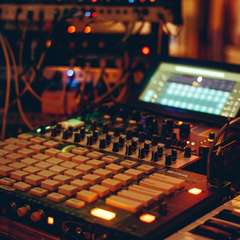Mastering the Low End: Balancing Sub Bass and Kicks for Clear Mixes
As a producer, one of the most challenging aspects of mixing is getting the low end right. The relationship between your sub bass and kick drum can make or break the overall clarity and impact of your track. In this comprehensive guide, we'll dive deep into the art of balancing sub bass and kicks to achieve a powerful, well-defined low end that will have your listeners feeling the groove.
Understanding the Importance of Low-End Balance
The low end is the foundation of any dance track. It's what gives your music its weight, punch, and energy. However, if the sub bass and kick drum aren't working in harmony, the result can be a muddy, indistinct low end that leaves your track sounding flat and lifeless.
Achieving the perfect balance between these two critical elements is essential for creating a mix that cuts through the speakers and leaves a lasting impression on your audience. When done right, the interplay between the sub bass and kick can create a powerful, cohesive low-end that anchors the entire track and drives the listener's emotional response.
Identifying Common Low-End Issues
Before we dive into the techniques for balancing sub bass and kicks, it's important to understand the most common problems that producers face when working with the low end.
Muddiness and Lack of Clarity
One of the most common issues is a lack of clarity in the low end, where the sub bass and kick drum bleed into each other, creating a muddied, indistinct low-frequency range. This can make the track feel heavy and overwhelming, with no real definition or punch.
Frequency Masking
Another common problem is frequency masking, where the sub bass and kick drum occupy the same frequency ranges, causing them to compete for space in the mix. This can result in a loss of impact and definition, as the two elements struggle to be heard clearly.
Lack of Punch and Impact
When the sub bass and kick drum aren't working in harmony, the overall low-end impact of the track can suffer. The kick may feel weak and underwhelming, while the sub bass may lack the necessary punch and weight to drive the groove.
Techniques for Balancing Sub Bass and Kicks
Now that we've identified the common issues, let's dive into the techniques for achieving the perfect balance between your sub bass and kick drum.
1. Identify the Frequency Ranges
The first step is to understand the frequency ranges occupied by your sub bass and kick drum. Generally, the sub bass will live in the 20Hz to 100Hz range, while the kick drum will span the 60Hz to 200Hz range.
By identifying these frequency ranges, you can start to identify areas of overlap and potential masking issues. This will inform the EQ and processing decisions you make later on.
2. Use Subtractive EQ
One of the most effective ways to balance the sub bass and kick drum is through the use of subtractive EQ. Start by cutting the sub bass around the 80Hz to 100Hz range, which is where the kick drum's fundamental frequency often resides. This will help create space for the kick to punch through the mix.
Similarly, you can cut the kick drum around the 60Hz to 80Hz range to make room for the sub bass to shine. Be careful not to over-EQ, as this can result in a thin, lifeless low end.
3. Experiment with Parallel Processing
Another powerful technique is to use parallel processing to shape the sub bass and kick drum independently. Create a parallel channel for each element, and then apply different EQ, compression, and saturation settings to fine-tune their individual characteristics.
This approach allows you to sculpt the sub bass and kick drum without compromising the overall low-end balance. It also gives you more flexibility to experiment and find the perfect blend.
4. Utilize Sidechain Compression
Sidechain compression is a powerful tool for controlling the interaction between the sub bass and kick drum. By setting the kick drum as the sidechain trigger, you can duck the sub bass every time the kick hits, creating a clear, defined low end that maintains the necessary punch and impact.
Experiment with the attack and release settings of the sidechain compressor to find the perfect balance between the sub bass and kick. You may also want to try using a multiband compressor to target specific frequency ranges.
5. Adjust the Envelope and Transients
The envelope and transients of your sub bass and kick drum can also play a significant role in the overall low-end balance. Try adjusting the attack, decay, sustain, and release settings to find the perfect blend.
For example, you might want a longer sustain on the sub bass to create a more powerful, rumbling low end, while a shorter attack and decay on the kick can help it cut through the mix more effectively.
6. Monitor in Different Environments
Finally, it's important to monitor your mix in a variety of environments, from high-end studio speakers to small laptop speakers and even car audio systems. This will help you identify any problem areas and make the necessary adjustments to ensure your low end translates well across different playback systems.
Putting it All Together
Mastering the low end is an ongoing process that requires patience, experimentation, and a keen ear. By following the techniques outlined in this guide, you'll be well on your way to creating powerful, well-defined mixes that will have your listeners feeling the groove.
Remember, the key to a great low end is balance. By carefully sculpting the relationship between your sub bass and kick drum, you can unlock a new level of clarity, punch, and impact in your productions. So, get to work, and start mastering the low end!









